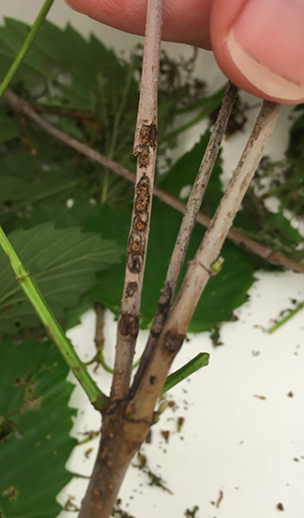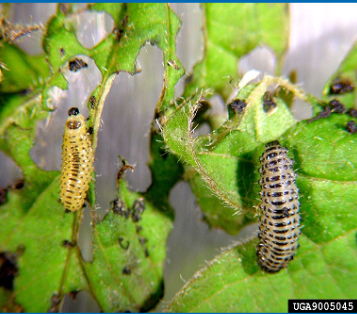Click below to listen to my 2 min. Garden Bite radio show: A new invasive bug on the loose
Audio PlayerI was just talking about the Viburnum shrub last week and all the various species and cultivars. And, unfortunately today, I’m talking about an invasive beetle that attacks viburnum plants.
It’s been confirmed in Minnesota for the first time. The Minnesota DNR says the viburnum leaf beetle somehow “hitched a ride from outside Minnesota” and found its way to the Twin Cities.

It’s hard to nail down exactly how it got here. Angie Ambourn, Supervisor of the MDA’s Pest Detection Unit said, “Unfortunately, this is yet another example of the ease at which invasive insects, plants, and diseases can quickly spread throughout the U.S. and the world.” The beetle in question was found in Eden Prairie, with a resident noticing them feeding on arrow-wood viburnum leaves in June.


The viburnum leaf beetle is yellow to light brown, with black spots and dashes on their bodies.

It’s an invasive insect native to Europe but up until now has only been found in the northeastern U.S. and Wisconsin, feeding exclusively on varieties of the viburnum flowering plant. It defoliates the plant initially, weakening it to the point that it eventually can die. As well as chewing holes in the leaves, the adults also lay eggs along the twigs in “egg pits that are easily seen with the naked eye.”
Click HERE for more from Cornell on viburnum species.
The spread can be controlled by selecting viburnum varieties resistant to the insect, as well as pruning and destroying infested twigs. “It’s important that we get an understanding of where this insect may be in Minnesota and how big of an issue this is to homeowners,” said Ambourn, with the DNR wanting residents to call send in photos and locations to arrest.the.pest@state.mn.us, or by calling 1-888-545-6684).
There are a few cultivars resistant, one with the most resistance includes the Korean Spice, which is very popular and wonderfully scented. As you browse resistant viburnum be sure to READ the zone hardiness, sun/shade and soil requirements. As I said last week, there are many types with varied needs.

